TAGGED: lumerical
-
-
March 10, 2023 at 6:38 pm
jungtaek.kim
SubscriberHi there,
I am using the Lumerical to simulate a simple structure with three layers.
However, there is discrepancy between results by stackrt and simulations.
Even if I set up periodic boundary conditions for x, y directions (it will make infinite three layers), the results are not mached to the result by stackrt.
As shown in the figure attached, it is quite similar, but the discrepancy is larger in the region of small grid sizes (sizes of three-layer object) than the other region.
Moreover, it is not also matched in the region of large grid sizes.
Is it led by the design or unavoidable numerical error of the Lumerical or is there any problem in my implementation?
Thank you in advance.
-
March 17, 2023 at 6:15 pm
Guilin Sun
Ansys Employeestackrt is analytical solution so it is accurate.
Simulation results depend on the simulation settings. Smaller gid size does not necessarily mean higher accuracy. When you used finer mesh, did you increase the PML layers to keep about the same thickness? if not, thin PML may not perform well and may reflect to reduce the net transmission.
Covergence testing in FDTD involves several setting adjustments. Please refer:
Convergence testing process for FDTD simulations
Please note that simulation from discrerized mesh will introduce discrete errors. Similar to experiments with measurement errors and setup errors as well as manufacturing errors, we can control them to certain level, but cannot eliminate them. If the simulation is accurate to certain decimals, it should be ok.
-
March 17, 2023 at 6:34 pm
jungtaek.kim
SubscriberThanks! It makes sense. I understood why it happens.
-
- The topic ‘Discrepancy between stackrt and simulations’ is closed to new replies.



-
3427
-
1057
-
1051
-
896
-
887

© 2025 Copyright ANSYS, Inc. All rights reserved.








